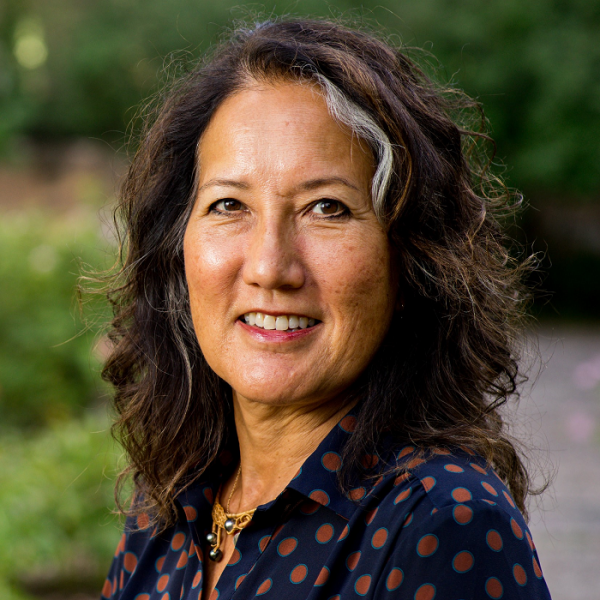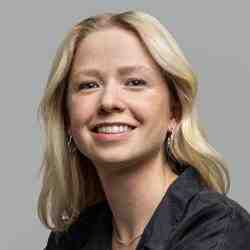Introduction
Paula Daniels is working to transform our food system through the nationally networked implementation of a powerful idea: the food purchasing of large institutions, which can and should better reflect society’s values of economic equity, environmental sustainability, and public health.
The New Idea
Paula Daniels led the creation of a cutting edge, procurement-based strategy that could shift a sizable portion of the U.S. food and agriculture toward the public values of wellbeing for people and planet. The strategy, called Good Food Purchasing Program, is now spreading rapidly throughout the country.
It is no secret that our food system is at a pivotal crossroads, dominated by a consolidated handful of multinational corporations controlling a system built almost entirely around profit margins and efficiency – often at the expense of health and environmental outcomes, as well as fair labor practices. To start making shifts in the food system, Paula drove forward an idea to create a market based incentive, using the purchasing prowess of large urban institutions to send value based market signals through the food system, at scale. She started this work as a program of the Los Angeles Food Policy Council, which she founded in 2011. When her program in Los Angeles started getting national attention, Paula and her talented team leader on the project spun it off into the Center for Good Food Purchasing, allowing for national adoption.
The Center for Good Food Purchasing guiding value categories are (1) supporting local economies (2) public health (3) valued workforce (4) animal welfare and (5) environmental sustainability, and Paula and her team are providing tools for public institutions that collectively spend billions of dollars on food each year to enable them to better align their procurement contracts with those values. Much like the way LEED certifications work in rating energy efficiency and environmental design in buildings, her program provides a flexible rubric for value based purchasing with metric based targets, then reviews, verifies and rates compliance levels. Paula and the team at the Center work with municipal agencies, school districts, and major food distribution companies to help them understand how their food dollars are making a difference, and how their intentional participation in creating changes in the food system can transform it. There are already 29 institutions enrolled in the program including entities in Los Angeles, Oakland, San Francisco, Austin TX, Chicago, Boulder, Cincinnati, Washington DC, New York and North Carolina. They expect to influence $1.5 billion in food spending across 30 markets by 2020.
The Problem
It is becoming conventional wisdom that there is a crisis in our food system, and there are increasing concerns about the handful of national and multinational corporations that control most of our modern food supply. Those “too big to fail” food corporations are faithfully executing the Nixon era mandate of “get big or get out.” They indeed got big, and learned how to supply lots of food to lots of people at cheap prices; but other values got squeezed out in the rush toward this expansive scale.
With the shift toward consolidated, industrially efficient agriculture and mass produced food came a rise in obesity, a loss of agricultural biodiversity, and a rise in nitrate pollution due to concentrated methods of farming and animal rearing. The problem list is longer than that, including: exploitative labor practices, tied to the so-called economies of scale; the public health threat from the overuse of antibiotics in concentrated animal feeding operations; the significant climate change impacts from intensive agriculture, which produces nearly a third of all harmful greenhouse gas emissions; destruction of habitat and forests; and exhaustion of freshwater and other natural resources. It’s the result of a linear, extractive, and ultimately destructive model, provoked now into an accelerating trajectory of hyper-industrialization by the introduction of robotics and genetic engineering.
A confluence of powerful forces maintain the status quo: near-monopolistic control of our food production – buoyed by mid-century policies and subsidies at the state and federal levels – that makes it harder for small-to-medium producers to compete, as well as complex and disconnected supply chains, and a mindset and habits that have developed that either accept or overlook the downsides of industrial agriculture. The U.S. spends less on food per capita than any other comparable nation, but the U.S. also has the highest rate of obesity, per the World Health Organization. Over the last 10 years, however, demand for alternatives have grown, boosted by research that ties manufactured, processed food to chronic health problems and that suggests in the long run regenerative agriculture would cost us less when you consider the full costs – including the negative impacts -- of our existing system. The perennial challenge is to devise a path forward that is both ambitious but pragmatic, and that could produce true systems change within an industry that is as complex as they come.
The Strategy
Paula and her team advance the Good Food Purchasing Program in key markets where there is a readiness in the community and in the public sector to have a deep understanding of all the moving parts, the potential, and a clear eyed view of any roadblocks. Her team provides hands-on assistance and support in meeting the goals of the program, which is now spreading rapidly throughout the country through word of mouth. The team expects to influence $1.5 billion in food spending by 2020. Paula’s goal is to ultimately shift 20-30 percent of each regional food market which, much like the impact of renewable energy programs, would be enough to influence market behavior and spur innovation along the supply chain.
The Good Food Purchasing Program was born during Paula’s time as a senior official with the City of Los Angeles. As one of her many key initiatives, she formed one of the country’s most influential food policy councils, considered so due to its unique organizational structure (led by her through the Mayor’s Office) and a strong partnership with leaders from all key sectors of the food system. Within three years of the launch of her regional food policy initiative, she persuaded the Mayor of City of Los Angeles to direct its adoption throughout city departments. Through her efforts, LA Unified School District (the second largest school district in the country) adopted it a month later. The adoption of the program by LAUSD showed immediate results: local sourcing of produce increased, directing $12 million into the local food economy, and creating 150 new jobs in regional food processing. Through her leadership role in the US Conference of Mayors Food Policy Task Force, national interest in the program became apparent, so Paula and her core team spun the program off into the independent Center for Good Food Purchasing, which runs the program. Two key aspects of their approach led to the credibility and success of the program: The first is the importance of bringing together stakeholders across issue areas and sectors into the design and development process, enabling transparent decision-making and avoiding any undue surprises during implementation. Another is the flexible design of the program, which Paula credits her co-founder Alexa Delwiche with creating in a “eureka” moment after an extensive series of iterations in program design. Lastly, the approach has a clear set of metrics, verification of implementation, and a rating system, so that it is clear to institutions exactly how to comply with the standards.
Changing the food system means creating a system based on values. With input from many peers in the food reform sector as well as those in the industry, Paula and her team established a new set of values based food sourcing standards that are one of the most comprehensive in the country. While others focus predominantly on one or two values, their program incorporates all five that were important to the stakeholder community they worked with, including labor practices and animal welfare. Each value category is implemented through metrics and guidance toward ranked levels of existing certifications, such as USDA Organic or Certified Humane. For example, in the nutritional health value category, there is a 25-item checklist that ranges from procurement-oriented targets (such as purchasing seasonally, or purchasing leaner meats) to food service environment targets (such as eliminating the use of deep frying or replacing unhealthy items with healthier ones near checkout points and registers).
With the guiding values clearly articulated, Paula’s work focuses on encouraging large institutions to direct their buying power toward those values. The Center works with institutions to establish supply chain transparency from “farm to fork”, evaluate how current purchasing practices align with the five standards, assist with goal setting, measure progress, and celebrate successes in shifting toward a new system. Good Food Provider verification seals are provided to participating institutions that meet baseline requirements and that satisfy the four components of adoption: standards, reporting, verification, and transparency.
Paula targeted the school district as the initial unit of change in part because of her knowledge of the role that governments can play in implementing public values, and also because there was a growing swell of community interest in the food system’s role in children’s health and welfare. In addition, school districts are usually the largest food service provider in any region, and so their food dollars are highly influential. LA Unified School district, for example spends around $100 million on food purchasing per school year, and serves a million meals per day. All told, institutional food procurement in the US is more than $150 billion, according to the USDA Economic Research Service.
Paula’s unique combination of big ambition together with gradualism is one of the reasons she is so successful at building diverse coalitions and driving large scale initiatives toward early success. She understands that cities can’t go from zero to 100 overnight, nor can the many moving parts across the supply chain. Compliance with the five values, therefore, begins at an achievable threshold – 15 percent of locally sourced food, for example – with an expectation of progress over time, to get to 25 percent in each category within five years. And the work of her team is equal parts political savvy (who to bring together around a table at what moments) and nuts and bolts technical support (the earlier a school district sets its menus for the semester, the better able for medium-size local growers to meet demand and avoid having to go to the massive supplier at the last minute).
The change in Los Angeles happened almost immediately. Among other things, this has resulted in Los Angeles moving from just 10 percent local sourcing of produce to an average of 60 percent. The Center has subsequently gotten the cities of San Francisco, Oakland, and Chicago, and New York on board. Each additional city represents a new member of what Paula calls a “community of practice” – an intentional network that through the Center can connect, share best practices, and contribute to a growing movement with national ambition. The Center collaborates with other peer organizations with national reach or regional focus, as a way to gain entry and traction in new regions.
Paula recognized that a strategy for political and policy support will be necessary to allow the leading school districts and other institutions in this effort to fully commit to championing food system reform over the long term. For that purpose, she designed the Good Food Region Initiative – which is intended as a public-private partnership to leverage the combined resources of government and private institutions, concentrating them in a place-based model of regions identified through a competitive process. The goal is that the selected Good Food Regions will be provided financial and technical incentives to support a cohort of large institutions within the regions in making transformative changes in their supply chains. Services may include: one-on-one technical support from state agencies to support implementation of Good Food procurement strategies, access to peer networks, priority access to state funding opportunities, policy interventions such as higher reimbursement rates for school meals, supply chain verification and impact evaluation, political accountability, and recognition. Starting with a pilot in California, the plan is for national expansion through a subnational (states to regions) approach, with its goal of creating collective impact via an empowered loci of transformation in the context of a region. She is pleased have found a partner in PolicyLink, for the research and development of this initiative,
The Center for Good Food Purchasing was founded in July of 2015 and its projected budget for 2018 is $700,000, up from $350,000 last year and $100,000 in its first official year. About one third of its revenue is earned income from fee for service contracts for evaluation of the program, and Paula’s goal is to reach over 50 percent earned income by 2020.
The Person
Paula and her team advance the Good Food Purchasing Program in key markets where there is a readiness in the community and in the public sector to have a deep understanding of all the moving parts, the potential, and a clear eyed view of any roadblocks. Her team provides hands-on assistance and support in meeting the goals of the program, which is now spreading rapidly throughout the country through word of mouth. The team expects to influence $1.5 billion in food spending by 2020. Paula’s goal is to ultimately shift 20-30 percent of each regional food market which, much like the impact of renewable energy programs, would be enough to influence market behavior and spur innovation along the supply chain.
The Good Food Purchasing Program was born during Paula’s time as a senior official with the City of Los Angeles. As one of her many key initiatives, she formed one of the country’s most influential food policy councils, considered so due to its unique organizational structure (led by her through the Mayor’s Office) and a strong partnership with leaders from all key sectors of the food system. Within three years of the launch of her regional food policy initiative, she persuaded the Mayor of City of Los Angeles to direct its adoption throughout city departments. Through her efforts, LA Unified School District (the second largest school district in the country) adopted it a month later. The adoption of the program by LAUSD showed immediate results: local sourcing of produce increased, directing $12 million into the local food economy, and creating 150 new jobs in regional food processing. Through her leadership role in the US Conference of Mayors Food Policy Task Force, national interest in the program became apparent, so Paula and her core team spun the program off into the independent Center for Good Food Purchasing, which runs the program. Two key aspects of their approach led to the credibility and success of the program: The first is the importance of bringing together stakeholders across issue areas and sectors into the design and development process, enabling transparent decision-making and avoiding any undue surprises during implementation. Another is the flexible design of the program, which Paula credits her co-founder Alexa Delwiche with creating in a “eureka” moment after an extensive series of iterations in program design. Lastly, the approach has a clear set of metrics, verification of implementation, and a rating system, so that it is clear to institutions exactly how to comply with the standards.
Changing the food system means creating a system based on values. With input from many peers in the food reform sector as well as those in the industry, Paula and her team established a new set of values based food sourcing standards that are one of the most comprehensive in the country. While others focus predominantly on one or two values, their program incorporates all five that were important to the stakeholder community they worked with, including labor practices and animal welfare. Each value category is implemented through metrics and guidance toward ranked levels of existing certifications, such as USDA Organic or Certified Humane. For example, in the nutritional health value category, there is a 25-item checklist that ranges from procurement-oriented targets (such as purchasing seasonally, or purchasing leaner meats) to food service environment targets (such as eliminating the use of deep frying or replacing unhealthy items with healthier ones near checkout points and registers).
With the guiding values clearly articulated, Paula’s work focuses on encouraging large institutions to direct their buying power toward those values. The Center works with institutions to establish supply chain transparency from “farm to fork”, evaluate how current purchasing practices align with the five standards, assist with goal setting, measure progress, and celebrate successes in shifting toward a new system. Good Food Provider verification seals are provided to participating institutions that meet baseline requirements and that satisfy the four components of adoption: standards, reporting, verification, and transparency.
Paula targeted the school district as the initial unit of change in part because of her knowledge of the role that governments can play in implementing public values, and also because there was a growing swell of community interest in the food system’s role in children’s health and welfare. In addition, school districts are usually the largest food service provider in any region, and so their food dollars are highly influential. LA Unified School district, for example spends around $100 million on food purchasing per school year, and serves a million meals per day. All told, institutional food procurement in the US is more than $150 billion, according to the USDA Economic Research Service.
Paula’s unique combination of big ambition together with gradualism is one of the reasons she is so successful at building diverse coalitions and driving large scale initiatives toward early success. She understands that cities can’t go from zero to 100 overnight, nor can the many moving parts across the supply chain. Compliance with the five values, therefore, begins at an achievable threshold – 15 percent of locally sourced food, for example – with an expectation of progress over time, to get to 25 percent in each category within five years. And the work of her team is equal parts political savvy (who to bring together around a table at what moments) and nuts and bolts technical support (the earlier a school district sets its menus for the semester, the better able for medium-size local growers to meet demand and avoid having to go to the massive supplier at the last minute).
The change in Los Angeles happened almost immediately. Among other things, this has resulted in Los Angeles moving from just 10 percent local sourcing of produce to an average of 60 percent. The Center has subsequently gotten the cities of San Francisco, Oakland, and Chicago, and New York on board. Each additional city represents a new member of what Paula calls a “community of practice” – an intentional network that through the Center can connect, share best practices, and contribute to a growing movement with national ambition. The Center collaborates with other peer organizations with national reach or regional focus, as a way to gain entry and traction in new regions.
Paula recognized that a strategy for political and policy support will be necessary to allow the leading school districts and other institutions in this effort to fully commit to championing food system reform over the long term. For that purpose, she designed the Good Food Region Initiative – which is intended as a public-private partnership to leverage the combined resources of government and private institutions, concentrating them in a place-based model of regions identified through a competitive process. The goal is that the selected Good Food Regions will be provided financial and technical incentives to support a cohort of large institutions within the regions in making transformative changes in their supply chains. Services may include: one-on-one technical support from state agencies to support implementation of Good Food procurement strategies, access to peer networks, priority access to state funding opportunities, policy interventions such as higher reimbursement rates for school meals, supply chain verification and impact evaluation, political accountability, and recognition. Starting with a pilot in California, the plan is for national expansion through a subnational (states to regions) approach, with its goal of creating collective impact via an empowered loci of transformation in the context of a region. She is pleased have found a partner in PolicyLink, for the research and development of this initiative,
The Center for Good Food Purchasing was founded in July of 2015 and its projected budget for 2018 is $700,000, up from $350,000 last year and $100,000 in its first official year. About one third of its revenue is earned income from fee for service contracts for evaluation of the program, and Paula’s goal is to reach over 50 percent earned income by 2020.




